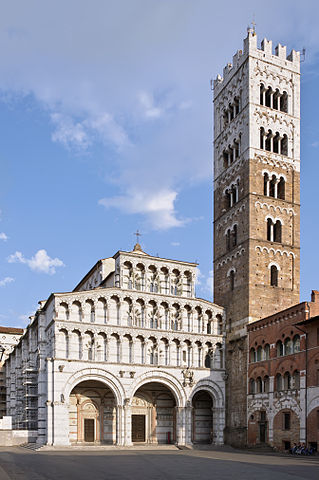Lucca, one of the best preserved medieval towns of Tuscany and birthplace of Giacomo Puccini, is well known to opera lovers, but its fame got a huge hike in the last few years thanks to the comics convention that takes place here in October, Lucca Comics, the most important comics-related event in Italy and one of the biggest conventions in the whole Europe.
Lucca is a true jewel, its walls, its paved roads and squares make it perfect to be explored on foot. Besides its unique atmosphere, you’ll definitely enjoy Lucca’s historic cafés and osterie, where you have the chance to taste the delicious local specialties.
The town has been founded by the Etruscans and then conquered by Romans in 180 B.C. The city has seen its golden age between the 14th and the 16th century. World War II’s bombings spared Lucca and thanks to that, today we can admire the beauty of its old town.
What to see
The main street, Via Filungo, will lead you to the heart of the town, on your sides you’ll see elegant boutiques hosted in ancient buildings, and little cafés, the perfect spots for a quick break.
. This elliptical square is one of the most beautiful of the entire Tuscany; it owes its name to the amphitheatre that was located here when the Romans ruled over Europe. Today the square is framed by historic cafés and medieval houses, but among the buildings you can still found what remains of the Roman theatre.
Palazzo Pfanner. This romantic building has been built during the 17th century. Climb the stairs and get to the first floor to admire the beauty of its interior, adorned by frescos and baroque decor. Then walk across the ornamental garden embellished by 17th century sculptures. The palace owes its name to the Austrian Felix Pfanner, who introduced beer in Italy and for many years used the basement of the building to produce it. From August to October Palazzo Pfanner hosts chamber music concerts.
Walls of Lucca. The majestic walls of the town have been built between the 16th and the 17th century and they’re perfectly preserved. Along the walls there’s a tree-lined path, great for an evening walk or a bike ride in the afternoon.
San Martino Cathedral. Lucca cathedral dates back to the 11th century  and its facade is the classic example of Romanesque architectural style, even if it has been designed to include the preexisting bell tower. The interior has been completely renovated between the 14th and th 15th century with Gothic additions. The crucifix of the cathedral, says the legend, has been sculpted by Nicodemo who was one of the witnesses of the crucifixion. Among the many artworks hosted inside the cathedral, don’t forget to go visit Tintoretto’s Last Supper, above the third altar of the Southern aisle, and the Madonna in trono con santi by Domenico Ghirlandaio, in the sacristy.
and its facade is the classic example of Romanesque architectural style, even if it has been designed to include the preexisting bell tower. The interior has been completely renovated between the 14th and th 15th century with Gothic additions. The crucifix of the cathedral, says the legend, has been sculpted by Nicodemo who was one of the witnesses of the crucifixion. Among the many artworks hosted inside the cathedral, don’t forget to go visit Tintoretto’s Last Supper, above the third altar of the Southern aisle, and the Madonna in trono con santi by Domenico Ghirlandaio, in the sacristy.
Chiesa dei Santi Giovanni e Reparata. The interior of this 13th century deconsacrated church is truly evocative and perfect to host operatic recitals: the church de facto is Lucca’s opera house and its stage has seen the most important opera singers of Europe.
Museo Villa Puccini. The house of Puccini has been preserved exactly as it was when the musicist lived here. Guided tours are available to visit the villa, whose garden hosts the famous Festival Pucciniano in summer (www.puccinifestival.it).
Where to eat
Da Felice (Via Buia, 12). This crowded pizzeria is the best in town, you can stop by for lunch and have a cecina or a castagnaccio. It is located right behind Piazza San Michele, and it’s really easy to find.
Osteria del Manzo (Via Battisti, 28). Most of the times the restaurants where locals usually go are far from the town centre, and that’s the case. Under Osteria del Manzo’s beamed roofs though you’ll taste delicious specialties cooked with the best local ingredients.
Buca di Sant’Antonio (Via della Cervia, 3). This charming restaurant has been founded in 1782 and it’s the best place you’ll find in Lucca if you want to taste some high end Italian wines. The cuisine here is just the same of any other osteria in town, but the atmosphere is worth a visit. Reservation is required.
Enoteca Calasto (Piazza San Giovanni, 5). This isn’t actually a restaurant, but a wine shop run by an English woman and a Danish man. This strange couple will offer you the most typical selection of local wines and on Thursdays tasting sessions for just 5€, so what are you waiting for?






